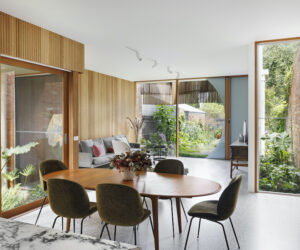A New Generation of Innovative Timber Products
The balance between conservation of our wild natural places and producing enough beautiful wood products to meet society’s demands, is not an easy task. But it’s vital that we get it right. Because as The Ultimate Renewable resource, trees are part of the solution to the greatest challenge of our time – climate change. Enthusiasts of using timber across their range of large-scale projects, Sydney architecture firm Fitzpatrick + Partners were invited to take part in the Visiting Architects Program, an experience designed to showcase Tasmania’s forest management practices and forest products. The firm got an up-close glimpse of the innovative forest products that are leading the nation’s forestry sector and how Tasmania’s processors are committed to getting the most out of every log.
Big Ideas, New Products
A long-time admirer of Tasmanian timber species, Founding Principal, James Fitzpatrick of Fitzpatrick + Partners explains the depth of innovation and product development that’s taking place in the forest industry in Tasmania.
“New products and new ideas are being developed and there’s a huge depth of R&D into new technologies and systems that way surpasses what we have seen and knew of before,” says Fitzpatrick.
“There’s a whole new generation of products, some twelve months away, some five years away, that are really going to open the market and take it to the next level.
“Another big takeaway was the efficiencies of the systems. Every piece of material is used and reused. The waste is used to feed the mills, and it’s even being fed into the community to power the local swimming pool for pool-heating and things like that. That whole closed system was really fascinating to see.”
A Plethora of Products
Rod Pindar, Partner at Fitzpatrick + Partners, was also present for the Visiting Architects Program. With years of experience in the architecture industry, Pindar shares how impressed he was with the innovation displayed at each step of the process by Tasmanian timber suppliers. The first stop on the Tasmanian experience was McKay Timber.
“The key thing for me that stood out was when we went to see Brett [McKay] at McKay Timber. Just the sheer range of product that they’re creating from a single timber source,” explains Pindar.
“Tassie Oak is stacked up through the whole yard. The sheer volume is pretty impressive, but so is the variety of products that they’re using Tas Oak for including all the off cuts.
“Brett pulled the smaller off cuts out of a bin saying: ‘we’re now looking at reusing these for finger joints’. He’s putting them into an engineered process to reuse the timber and also looking at biofuels – trying to have almost a 100% closed loop cycle for the mill. That’s a great initiative that he’s working towards,” says Pindar.
An Industry of Innovation
Taking the industry to uncharted levels of innovation, Pindar explains that an old material that for a long time was overlooked, is now being extensively studied, examined and reworked to become a material that’s both cutting edge and sustainable.
“I think just the sheer variety of what they’re doing with that timber was quite impressive and there’s a lot of expertise that goes into that operation. The timber space is now moving into the innovation space,” Pindar explains.
“If you asked people generally, what do you picture when you think of innovation? It’s steel and concrete and computers and technology and all these things that timber isn’t. This old tried and tested material that we’ve been using for thousands of years is actually now moving into a space where it is cutting edge. Engineered timbers, the way that it’s sourced, the sustainability of the product, creating closed loop cycles-it’s all cutting edge stuff,” says Pindar.
“When you look at the construction sector, over the last 20, 30, 40 years, there haven’t been that many big leaps, that many big innovations. I think timber is the next big leap, and it’s proven that it can be.
“It’s interesting that there’s that counterpoint in the material where on the one hand, it’s so traditional and old school, and on the other hand, it’s so new and innovative, so I think that’s exciting, is really unique and it’s admirable.”
The Future of Timber
With the Visiting Architects Program now wrapped up, Fitzpatrick shares his excitement for the future of timber products and what the firm themselves will be doing to continue to push the boundaries on the innovation of timber building.
“There’s so much we’re seeing being developed at the [University of Tasmania] on different floor systems, different structural beam systems, which are really going to feed that next generation of timber buildings,” says Fitzpatrick.
“We’re taking the step forward and actually creating new technologies and new building systems and we’ll be teaming up with the university to do a lot more R&D work in that space as well.
“One of the things that has come out of this trip is actually building a new link to the University here where we’ll be looking at placing students and doing key projects and research pieces and that’s quite exciting to us that it’s actually creating solutions to problems through innovation.”
A New Generation of Innovative Timber Products with Sustainability at Their Core



